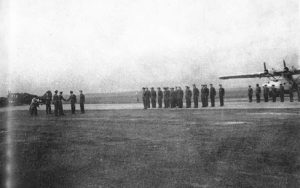
History
Throwback Thursday: DDT’s history in Canada
Why the pesticide DDT was revered after the Second World War
- 480 words
- 2 minutes
This article is over 5 years old and may contain outdated information.
History

Dichlorodiphenyltrichloroethane. The word is a mouthful. The chemical, commonly known as DDT, was at one time the most popular pesticide in the world.
DDT is now infamous for the harm it can cause to the environment and humans, but at the peak of its popularity in the 1940s, the chemical was featured in a Green Cross ad published in the July 1946 issue of the Canadian Geographical Journal. The half-page ad, pictured at right, touts the product as “the modern way to beautiful healthy flowers.” It suggests homeowners, “spray regularly with Green Cross DDT Flower Spray.”
During the Second World War, troops and civilians abroad were sprayed with the stuff to control vector-borne disease such as typhus and malaria. Back home, trucks spewed a fine mist of the colourless, odorless liquid in suburban neighborhoods to combat insects, as children frolicked in the chemical fog.
While incredibly effective, mounting evidence in the 1950’s began to suggest that DDT’s persistence in the environment, originally considered a positive characteristic, could reach toxic levels, and its ability to harm the nervous system in pests, another one of its strengths, was also true for humans. By the 1950’s and 1960’s, the insecticide became highly regulated in North America, and by the early 1970’s it was banned or restricted in the U.S., Canada and most of Europe. Since then, animal studies have linked DDT to reproductive issues and tumors, classifying it globally as a probable carcinogen.
While it hasn’t been used in Canada for about 25 years, traces of DDT have been found in the Arctic, where it was never sprayed, in human fat tissue and breast milk, as well as in the soil, water and snow. DDT is however still used in developing countries, but mostly to control mosquito-borne malaria.

(Image: Can Geo Archives)
Are you passionate about Canadian geography?
You can support Canadian Geographic in 3 ways:

History
Why the pesticide DDT was revered after the Second World War

History
A book by environmental historian Daniel Macfarlane reveals the decades of technological feats and cross-border politics that went into “fixing” one of North America’s most important natural sites

History
Sometime around midnight on March 30, 1848, the Niagara River 'ran dry from lake to lake.'

People & Culture
Westaway Explorer-in-Residence Adam Shoalts shares a portion of his story from his 3,400 solo journey from Long Point on Lake Erie to Ungava Bay on the Arctic coast